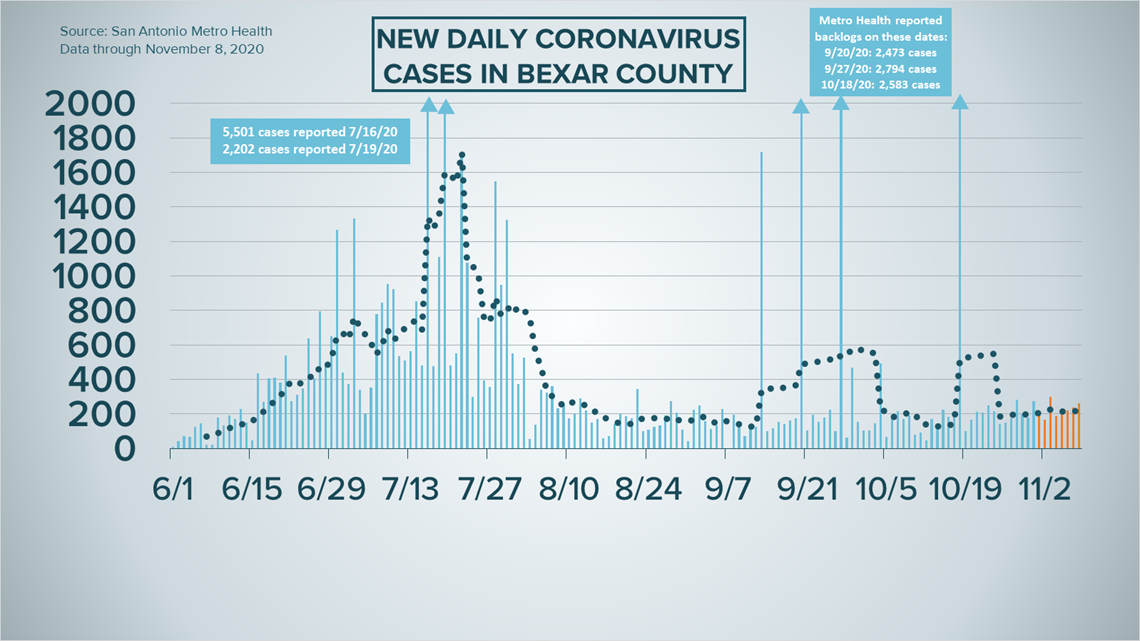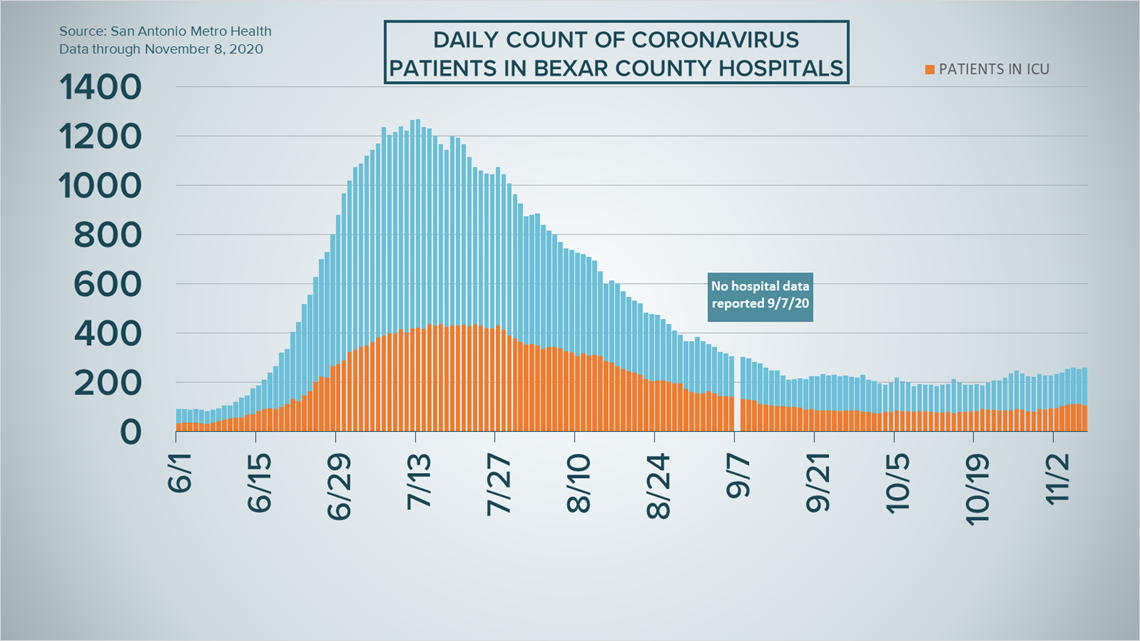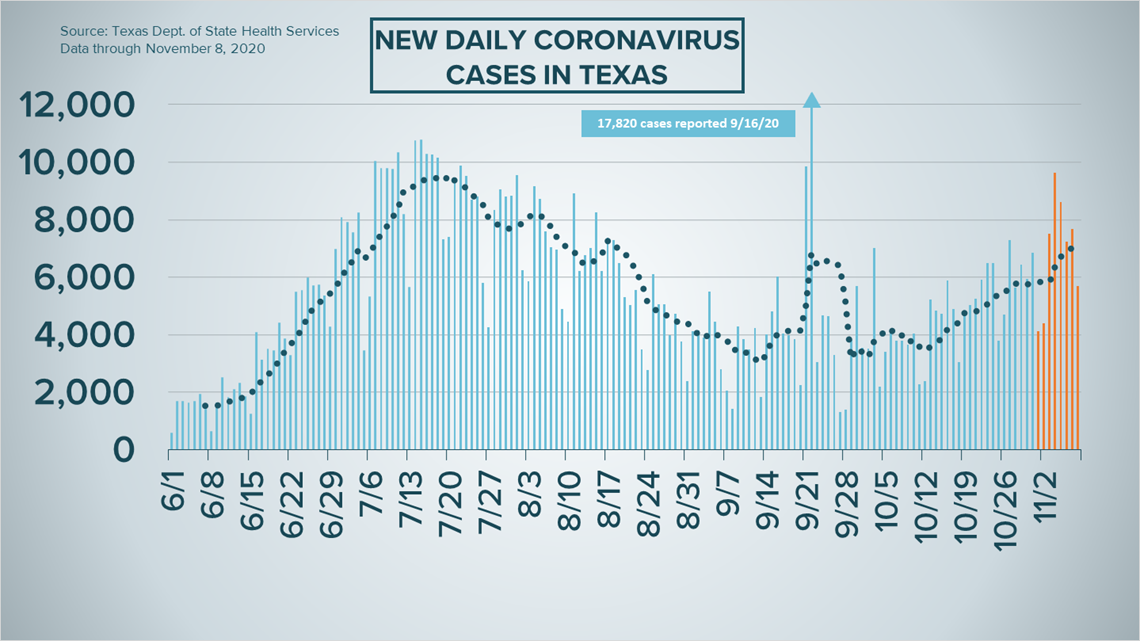SAN ANTONIO — We're tracking the latest numbers from the coronavirus pandemic in San Antonio and across Texas. Here are the latest numbers reported by Bexar and surrounding counties:
- Bexar County: 88 new cases were reported Sunday in addition to a backlog of 174, bringing the total number of cases for the county to 67,627). No new deaths were reported, but there was a backlog of 12, raising the death toll to 1,285.
- Comal County: The county reported 28 new COVID-19 cases Friday morning, as well as nine backlogged diagnoses. One new virus-related death was also reported. There have been a total of 3,881 reported cases of COVID-19 in the county – including 2,927 lab-confirmed cases – while 122 county residents have died. County officials say there are 173 active coronavirus cases, and 3,623 residents are considered recovered.
- Hays County: Officials in Hays County on Friday reported 18 new cases in the county and no additional virus-related deaths. As of Friday, there are a total of 6,331 lab-confirmed cases in the county (368 of which are active), while the death toll remained at 91. 5,872 residents have recovered from the virus.
How Bexar County is trending
We've tracked how many coronavirus cases have been confirmed in Bexar County from the time officials began reporting cases in March 2020. The graphic below shows the number of cases since June and charts those daily case numbers along a 7-day moving average to provide a more accurate picture of the overall coronavirus case curve in our area and the direction we're trending amid the pandemic.
On Sunday, Metro Health updated its online coronavirus dashboards to reflect an additional 262 coronavirus cases in Bexar County, 174 of which were attributed to a backlog. At least 67,627 county residents have been diagnosed with COVID-19 during the pandemic.


No new local deaths were reported, but a backlog of 12 deaths that occurred between August 9 and October 23 was counted. The Bexar County death toll from coronavirus complications has now risen to 1,285.
Hospitalizations in the county continued to rise on Sunday, with 274 COVID-19 patients receiving treatment at local facilities. That's 13 more overall from Saturday. There are currently 80 patients on ventilators and 116 in intensive care.


It's unclear how many of those patients are from El Paso, a region that has been particularly devastated by the virus in recent weeks. On Friday, local leaders said that 46 of 253 patients were from the west Texas city.
Coronavirus in Texas
The number of Texans who have tested positive for the coronavirus since the pandemic began grew by 5,685 on Sunday, according to the Texas Department of State Health Services.
5,404 of those are new diagnoses over the last 24 hours, while another 281 cases stem from a number of backlogs in several counties. More details can be found at the top of this page.
As of Sunday, at least 956,234 Texans have contracted COVID-19.


State health authorities also reported 43 additional virus-related deaths on Sunday. At least 18,743 Texans have passed away from COVID-19 complications.
Meanwhile, the overall number of Texans hospitalized for COVID-19 on Sunday rose slightly to a total of 6,080 Texas residents were receiving treatment. The beginning of November has continued a troubling trend reflecting a resurgence of COVID-19 spread in the Lone Star State that began in October; since Oct. 1, the number of Texas hospitalizations has spiked by 90.6%.
Experts attribute the recent spike in COVID-19 numbers to "pandemic fatigue."
The state estimates that 820,215 Texans have recovered, while 124,617 Texans remain ill with COVID-19.
Meanwhile, the latest update from the Texas Education Agency showed that there have been 31,987 cumulative cases among staff and students across the state through Nov. 1. More information can be found here.
The TEA releases new data on school cases every Thursday.
Latest Coronavirus Headlines
- US hits new COVID-19 daily record with 126,000 confirmed cases
- Browns place QB Baker Mayfield on COVID-19 list during bye
- Biden to announce COVID-19 task force Monday
- White House Chief of Staff Mark Meadows has coronavirus
- Grieving family shares important message ahead of the holidays
- Counties with worst coronavirus surges overwhelmingly voted for President Trump
- UTSA postpones football game against Rice
Coronavirus symptoms
The symptoms of coronavirus can be similar to the flu or a bad cold. Symptoms include fever or chills, cough, shortness of breath or difficulty breathing, fatigue, muscle or body aches, headache, new loss of taste or smell sore throat, congestion or runny nose, nausea or vomiting and diarrhea, according to the Centers for Disease Control.
Most healthy people will have mild symptoms. A study of more than 72,000 patients by the Centers for Disease Control in China showed 80 percent of the cases there were mild.
But infections can cause pneumonia, severe acute respiratory syndrome, kidney failure, and even death, according to the World Health Organization. Older people with underlying health conditions are most at risk.
But infections can cause pneumonia, severe acute respiratory syndrome, kidney failure, and even death, according to the World Health Organization. Older people with underlying health conditions are most at risk.
Experts determined there was consistent evidence these conditions increase a person's risk, regardless of age:
- Chronic kidney disease
- COPD (chronic obstructive pulmonary disease)
- Obesity (BMI of 30 or higher)
- Immunocompromised state (weakened immune system) from solid organ transplant
- Serious heart conditions, such as heart failure, coronary artery disease, or cardiomyopathies
- Sickle cell disease
- Type 2 diabetes
The CDC believes symptoms may appear anywhere from two to 14 days after being exposed.
Human coronaviruses are usually spread...
- Between people who are in close contact with one another (within about 6 feet).
- Through respiratory droplets produced when an infected person coughs, sneezes or talks. These droplets can land in the mouths or noses of people who are nearby or possibly be inhaled into the lungs.
- Some recent studies have suggested that COVID-19 may be spread by people who are not showing symptoms.
Help stop the spread of coronavirus
- Stay home when you are sick.
- Eat and sleep separately from your family members
- Use different utensils and dishes
- Cover your cough or sneeze with your arm, not your hand.
- If you use a tissue, throw it in the trash.

